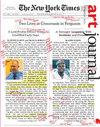Family Tensions
IF 0.3
3区 艺术学
0 ART
引用次数: 0
Abstract
Arlene Dávila’s Latinx Art: Artists, Markets, and Politics concludes with a “Noncomprehensive List of Artists Everyone Should Know,” which includes some 150 contemporary Latinx practitioners (177–88). Elizabeth Ferrer’s Latinx Photography in the United States: A Visual History is structured like a list throughout, with loosely chronological chapters that proceed photographer by photographer (many of whom are also artists) like an exhibition catalog. The books share eighteen names in common, as well as the same presupposition that many are unfamiliar to the reader. As Ferrer notes, “I have striven to include as many historic photographers as possible to help fill gaps in our understanding of the scope of contributions made by Latinx individuals to the medium” (xii). For both Ferrer and Dávila, Latinx art and photography are challenged not merely by restricted access—to museums, art markets, canons, and even “Latin American art” itself—but by amnesia as well. Ferrer provides an accessible introductory resource to Latinx history and culture as refracted through a particular medium and its proponents. Dávila has crafted something else entirely; Latinx Art is only nominally art history. An anthropologist by training, her research is premised on “interviews with artists, curators, gallerists, and other stakeholders of the contemporary art circuit” whose perspectives are interwoven with Dávila’s own excoriation of the pre-COVID-19 art world for its exclusion and “whitewashing” of Latinx artists (2). The subfield of Latinx art history thus arrives with its own debates in full swing. Both books necessarily reflect on terminology and define the vexed ethnoracial category “Latinx,” which first trended on Google in 2004 as a nonbinary iteration of “Latina” or “Latino.”1 The latter were originally short for latinoamericana/o (Latin American), but Ferrer, following the term’s conventional usage, defines “a Latinx person as one who resides in the United States and whose family roots can be traced to a Spanish-speaking country in the Americas”(ix). She does so to eschew,家庭紧张
阿琳·达维拉(Arlene Dávila)的《拉丁裔艺术:艺术家、市场和政治》(Latinx Art:Artists,Markets,and Politics)以一份“每个人都应该知道的非综合艺术家名单”结尾,其中包括约150名当代拉丁裔从业者(177-88)。伊丽莎白·费雷尔(Elizabeth Ferrer)的《美国拉丁裔摄影:视觉史》(Latix Photography in the United States:A Visual History。这两本书共有十八个名字,还有一个读者不熟悉的前提。正如费雷尔所指出的,“我努力让尽可能多的历史摄影师参与进来,以帮助填补我们对拉丁裔个人对媒体贡献范围的理解空白”(xii)。对于费雷尔和达维拉来说,拉丁裔艺术和摄影不仅受到博物馆、艺术市场、经典,甚至“拉丁美洲艺术”本身的限制,还受到健忘症的挑战。费雷尔为通过特定媒介及其支持者折射的拉丁裔历史和文化提供了一个可访问的介绍资源。达维拉完全另辟蹊径;拉丁裔艺术只是名义上的艺术史。作为一名受过训练的人类学家,她的研究以“采访艺术家、策展人、画廊老板和当代艺术界的其他利益相关者”为前提,这些人的观点与达维拉自己对新冠疫情前艺术界排斥和“洗白”拉丁裔艺术家的谴责交织在一起(2)。因此,拉丁裔艺术史的子领域也随之展开了激烈的辩论。这两本书都必须反思术语,并定义了棘手的民族种族类别“拉丁裔”,该类别于2004年首次在谷歌上流行,是“Latina”或“Latino”的非二进制迭代。1后者最初是latinoamericana/o(拉丁美洲)的缩写,但Ferrer遵循该术语的传统用法,将“拉丁裔人定义为居住在美国,其家庭根源可以追溯到美洲的西班牙语国家”(ix)。她这样做是为了回避,
本文章由计算机程序翻译,如有差异,请以英文原文为准。
求助全文
约1分钟内获得全文
求助全文

 求助内容:
求助内容: 应助结果提醒方式:
应助结果提醒方式:


